4. Butterfly and Pollinator Paradise Garden
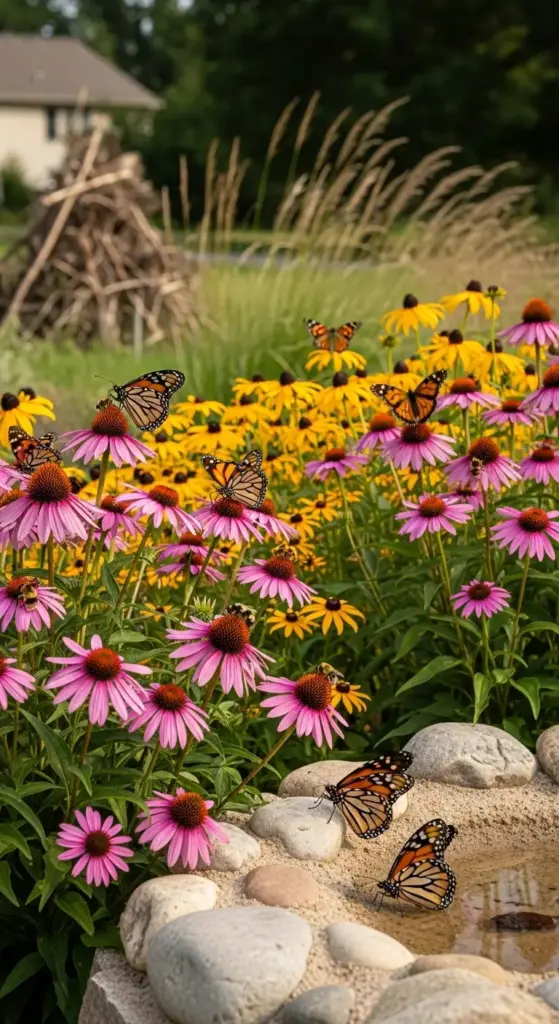
I’ll never forget the first monarch butterfly that visited my garden. I was so excited I called my neighbor over to see it, only to watch it fly away after about ten seconds.
That’s when I realized I had no idea how to actually keep pollinators around.
Native Plants That Actually Bring the Butterflies
The biggest mistake I made was planting pretty flowers that pollinators couldn’t care less about. Native flowering plants are the secret to creating a true pollinator paradise.
Purple coneflower (echinacea) is like a butterfly magnet. I planted three small plants and now have a massive patch that’s covered in monarchs, swallowtails, and painted ladies all summer long.
Black-eyed Susan blooms for months and feeds both butterflies and bees. The goldfinches love the seed heads in fall, so it’s like getting two gardens in one.
Bee balm lives up to its name – my patch buzzes with activity from dawn to dusk. The red varieties attract hummingbirds like crazy, while bees prefer the purple and pink ones.
Wild bergamot is basically bee balm’s cousin but handles drought better. It spreads naturally and creates those naturalized drifts that look amazing in photos.
For hummingbird plants, nothing beats cardinal flower and trumpet vine. The cardinal flower’s bright red spikes are like hummingbird candy, and trumpet vine provides nectar all season long.
Strategic Garden Layout for Maximum Pollinator Traffic
Pollinator garden design is totally different from regular flower garden planning. I learned this after watching butterflies fly right over my scattered single plants.
Mass plantings are crucial – pollinators need to see your flowers from a distance. I plant in drifts of at least 15-20 plants of the same species.
Clustering by bloom time keeps something flowering in each area throughout the season. My spring section has wild lupine and spicebush, summer area features coneflowers and bee balm, and fall zone is packed with asters and goldenrod.
Creating flight paths between flower clusters helps pollinators navigate your garden efficiently. I leave 3-4 foot wide pathways between major plantings.
Shelter areas are just as important as flowers. I planted native shrubs like elderberry and ninebark to give butterflies places to rest and hide from wind.
The goal is creating a pollinator highway system, not just pretty flower displays.
Seasonal Planting for Non-Stop Nectar
My first butterfly garden looked amazing in July but was basically useless the rest of the year. Continuous nectar sources require serious planning.
Early spring starts with native willows and redbuds. These trees provide crucial early nectar when most flowers aren’t blooming yet.
Late spring brings wild lupine, wild columbine, and phlox. These bridge the gap between tree blooms and summer perennials.
Early summer is when things really take off. Bee balm, wild bergamot, and purple coneflower start their long blooming seasons.
Mid-summer adds black-eyed Susan, butterfly weed, and native milkweeds. This is peak butterfly season in most areas.
Late summer features joe-pye weed, ironweed, and early asters. These keep the party going when many other flowers are fading.
Fall is all about asters and goldenrod. I know goldenrod gets blamed for allergies, but it’s actually ragweed that’s the problem. Goldenrod is a pollinator superstar.
Butterfly Puddling Stations That Actually Work
Nobody told me that butterflies need more than just flowers. Butterfly puddling stations provide essential minerals and water that nectar alone can’t supply.
My first puddling station was just a shallow dish of water. It sat empty all season because I didn’t understand what butterflies actually need.
Mud puddles work better than clean water. I mix garden soil with water to create shallow, muddy areas that butterflies can land on safely.
Sand and salt additions make puddling stations irresistible. I add a pinch of sea salt and some coarse sand to provide the minerals butterflies crave.
Shallow areas are crucial – butterflies can’t swim and need places to land. I use large saucers filled with pebbles and just enough water to keep things moist.
Consistent moisture is key. I check my puddling stations daily during hot weather and refill as needed. Dry puddling stations are useless puddling stations.
Creating Butterfly Nesting and Overwintering Sites
Butterfly habitat goes way beyond flowers. I learned this when I realized my garden was just a fast-food stop, not a place butterflies actually wanted to live.
Native host plants are essential for butterfly reproduction. Monarchs need milkweed, swallowtails need parsley family plants, and painted ladies need thistles.
Brush piles provide overwintering sites for many butterfly species. I pile fallen branches in a corner of my garden and leave them undisturbed all winter.
Leaf litter areas give butterflies places to hibernate and lay eggs. I stopped raking one section of my garden and it’s become a butterfly nursery.
Native grasses like little bluestem and buffalo grass host skipper butterfly caterpillars. They also provide winter shelter for beneficial insects.
Kid-Friendly Educational Elements
My family-friendly pollinator garden has become the neighborhood’s outdoor classroom. Kids are naturally fascinated by butterflies and bees.
Butterfly identification charts mounted on weatherproof boards help kids learn what they’re seeing. I laminated field guide pages and mounted them on fence posts.
Magnifying glasses on strings let kids examine flowers and insects up close. I keep a basket of them by the garden entrance.
Butterfly lifecycle displays using photos show kids how caterpillars become butterflies. I update the photos seasonally to match what’s happening in the garden.
Bee observation hives are amazing if you can manage them. My neighbor keeps bees and installed a small observation window that kids love watching.
Garden journals for kids to record their sightings create lasting memories. I provide clipboards and pencils in a weatherproof box.
Organic Pest Management That Protects Good Bugs
Organic pest control in pollinator gardens requires a completely different approach. You can’t just spray everything and hope for the best.
Beneficial insect habitat is your first line of defense. I planted yarrow, dill, and fennel to attract predatory insects that eat garden pests naturally.
Companion planting helps prevent pest problems before they start. Marigolds planted near vegetables repel many harmful insects without affecting pollinators.
Hand-picking pests is tedious but effective for small infestations. I check my plants weekly and remove problem insects before they multiply.
Neem oil is one of the few sprays I’ll use, and only in evening when pollinators aren’t active. It breaks down quickly and doesn’t harm beneficial insects when used correctly.
Row covers protect vulnerable plants without chemicals. I use them on vegetables during peak pest seasons, removing them when plants flower.
Common Pollinator Garden Mistakes to Avoid
Pesticide drift from neighboring properties can devastate pollinator populations. I planted a hedge of native shrubs along my property line to create a buffer zone.
Over-cleaning the garden removes essential habitat. I learned to leave some areas “messy” with fallen leaves and plant debris where beneficial insects overwinter.
Wrong plant choices happen when you buy plants labeled “butterfly garden” without checking if they’re actually native to your area. Native plants always work better than exotic alternatives.
Impatience kills more pollinator gardens than anything else. It takes 2-3 years for native plants to establish and start attracting significant pollinator populations.
Timing mistakes with garden cleanup can destroy overwintering insects. I wait until late spring to cut back perennials, giving insects time to emerge.
Measuring Your Pollinator Garden Success
Tracking pollinator visits helps you understand what’s working and what isn’t. I keep a simple log of butterfly and bee sightings throughout the season.
Photo documentation shows changes over time. My garden photos from year one versus year three are dramatically different – way more insects and activity.
Seed production in your plants indicates successful pollination. Heavy seed heads on coneflowers and black-eyed Susans mean the pollinators are doing their job.
Natural pest control improves as beneficial insect populations establish. I have way fewer aphid problems now that my garden supports predatory insects.
The most rewarding part of pollinator gardening? Knowing you’re making a real difference for struggling butterfly and bee populations. Every monarch that stops in my garden might make it to Mexico because of the fuel I provided.
My kids now recognize different butterfly species and get excited about bee activity. It’s turned our backyard into a living science classroom that changes every day.
Ready to create a magical evening garden experience that engages all your senses? Click “next” to discover how fragrant evening moon gardens can transform your outdoor space into a romantic nighttime paradise! 🌙
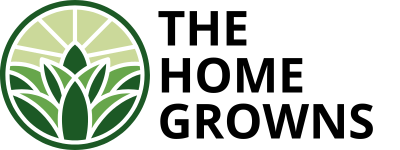




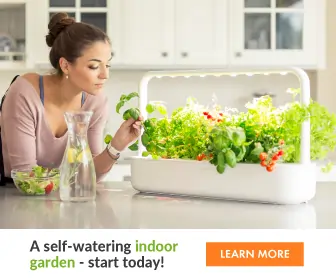

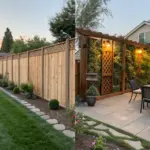
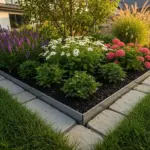
GIPHY App Key not set. Please check settings